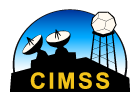
GOES-16 “Red” Visible (0.64 µm, top), Shortwave Infrared (3.9 µm, center) and “Clean” Infrared Window (10.3 µm, bottom) images, with hourly plots of surface reports [click to play MP4 animation]
4-panel comparisons of Suomi NPP VIIRS Visible (0.64 µm), Near-Infrared “Snow/Ice” (1.61 µm), Shortwave Infrared (3.74 µm) and Infrared Window (11.45 µm) images at 1936 UTC and 2029 UTC (below) revealed that the maximum differences between 3.74 µm and 11.45 µm cloud-top infrared brightness temperatures — at the same location on the pyroCb anvil — were 86ºC (+26ºC and -59ºC at 1936 UTC) and 91.5ºC (+27.5ºC and -63ºC at 2029 UTC).

Suomi NPP VIIRS Visible (0.64 µm, upper left), Near-Infrared “Snow/Ice” (1.61 µm, upper right), Shortwave Infrared (3.74 µm, lower left) and Infrared Window (11.45 µm, lower right) images at 1936 UTC and 2029 UTC [click to enlarge]
After dark, the thermal signature of the Mallard Fire was also apparent on GOES-16 Near-Infrared “Cloud particle size” (2.24 µm) imagery (below).

GOES-16 Near-Infrared “Cloud particle size” (2.24 µm, top), Shortwave Infrared (3.9 µm, center) and “Clean” Infrared Window (10.3 µm, bottom) images, with hourly plots of surface reports [click to play MP4 animation]
===== 12 May Update =====
![Terra MODIS True-color and False-color images [click to enlarge]](http://cimss.ssec.wisc.edu/goes/blog/wp-content/uploads/2018/05/180512_1703utc_terra_modis_truecolor_falsecolor_Mallard_Fire_TX_anim.gif)
Terra MODIS True-color and False-color images [click to enlarge]
The corresponding Terra MODIS Land Surface Temperature product (below) indicated that LST values within the burn scar were as high as 137ºF (darker red enhancement), in contrast to values around 100ºF adjacent to the burn scar.
![Terra MODIS Land Surface Temperature product [click to enlarge]](http://cimss.ssec.wisc.edu/goes/blog/wp-content/uploads/2018/05/MODIS_LST_20180512_1651.png)
Terra MODIS Land Surface Temperature product [click to enlarge]
![NOAA-19 AVHRR Visible (0.63 µm), Shortwave Infrared (3.7 µm) and Infrared Window (10.8 µm) images, with plots of 22 UTC surface reports [click to enlarge]](http://cimss.ssec.wisc.edu/goes/blog/wp-content/uploads/2018/06/180609_2207utc_noaa19_visible_shortwaveIR_IRwindow_anim.gif)

![NOAA-19 Visible (0.63 µm), Shortwave Infrared (3.7 µm) and Infrared Window (10.8 µm) images [click to enlarge]](http://cimss.ssec.wisc.edu/goes/blog/wp-content/uploads/2018/05/180522_2210utc_noaa19_visible_shortwaveIR_IRwindow_ON_pyrocb_anim.gif)

![Terra MODIS True-color and False-color images [click to enlarge]](http://cimss.ssec.wisc.edu/goes/blog/wp-content/uploads/2018/05/180512_1703utc_terra_modis_truecolor_falsecolor_Mallard_Fire_TX_anim.gif)
![Terra MODIS Land Surface Temperature product [click to enlarge]](http://cimss.ssec.wisc.edu/goes/blog/wp-content/uploads/2018/05/MODIS_LST_20180512_1651.png)
![Aqua MODIS True-color RGB image, with Suomi NPP VIIRS fire detection locations [click to enlarge]](http://cimss.ssec.wisc.edu/goes/blog/wp-content/uploads/2018/01/180129_aqua_modis_truecolor_Argentina_pyroCb_anim.gif)
![HYSPLIT forward trajectories originating at altitudes of 7, 9 and 11 km [click to enlarge]](http://cimss.ssec.wisc.edu/goes/blog/wp-content/uploads/2018/01/180129_18utc_Argentina_pyrocb_7_9_11_km_traj.gif)
![Suomi NPP OMPS Aerosol Index on 30 January [click to enlarge]](http://cimss.ssec.wisc.edu/goes/blog/wp-content/uploads/2018/01/180130_suomi_npp_omps_AI_Argentina_pyrocb.jpeg)



